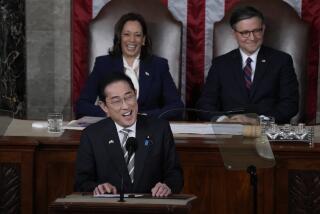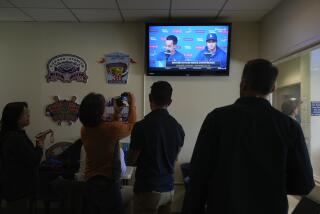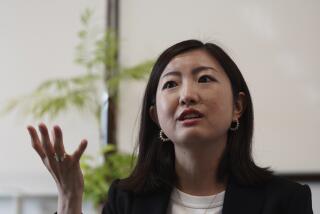SELLING AMERICAN TO THE JAPANESE : NEWS ANALYSIS : Free Trade Gives Way to Intervention : Policy: A plan drawn up by the Bush trade mission in Japan indicates that American policy is moving toward a managed trading arrangement.
- Share via
TOKYO — The “action plan” hammered out last week between President Bush and Japan’s Prime Minister Kiichi Miyazawa underscored a dramatic shift taking place in America’s Japan trade policy.
Bush, the avowed free trader, embraced a policy of managed trade where government intervenes in markets to control results. Instead of promoting free trade by simply calling for the removal of trade barriers, as the U.S. government has done in the past, U.S. trade negotiators also pushed for higher targets on Japanese purchases of American autos and auto parts.
The Japanese have to a large extent accepted the need for managed trade to cut the nation’s trade surplus. Indeed, many Japanese argue that the policies will only work if accompanied by further market-shaping policies--industrial policies--designed to make American industry more competitive. But many worry that Americans will use such agreements as a crutch to avoid dealing with American industry’s competitive weaknesses. They also see irony in American refusal to accept government intervention because of free market principles while at the same time demanding Japanese government intervention to promote Japanese imports of American products.
“Americans don’t want us to give administrative guidance, but at the same time they are pushing it on us,” said Sony Corp. Chairman Akio Morita in a television interview Sunday, referring to the Japanese government practice of guiding businesses activities.
Japan’s Ministry of International Trade and Industry (MITI) used “administrative guidance” to get Japanese auto companies to pledge to double their purchases of American auto parts to $19 billion by 1994, a target that was included in the agreement signed by Bush and Miyazawa last Thursday.
At one point even Miyazawa got involved in the act, calling Toyota Motor Co. President Shoichiro Toyoda at home one evening last week to try to get his cooperation.
“This is a very special deal we are giving them (the American auto industry),” said Japanese Foreign Minister Michio Watanabe regarding the Japanese promise to buy more American goods. “There is nothing that matches it anywhere else in the world.”
Japanese auto companies are not happy. An angry auto executive was quoted in one weekly recently saying that his company would have no use for the “low-quality” American auto parts and would have to “throw them in the Pacific Ocean.”
Although Japanese officials are against managed trade in principle, they recognize that it is bad politics for Japan to have a large trade surplus and are willing to use government power to badger Japanese companies into buying American, said MITI Vice Minister Noboru Hatakeyama in a surprisingly candid briefing on the summit talks.
The auto agreement is not the first case of managed trade. In what was initially a secret side letter to a semiconductor agreement in 1986, Japan agreed to raise to 20% from 8% the American share of the Japanese semiconductor market. Hatakeyama said the semiconductor agreement, renewed last year, has successfully boosted American chip sales in Japan, and he expressed confidence that the auto agreement would also prove effective.
If the auto agreement and the semiconductor agreement both prove effective, however, managed trade agreements could soon find their way into other areas of trade where Americans believe that their market share in Japan is too small.
Free traders complain that the trend toward managed trade could undermine the world system of free trade and presage a move toward protectionism.
But Japanese officials say the real danger to the world trading system comes not from such temporary arrangements as the auto and semiconductor agreements but from emotional arguments by American auto executives and protectionist politicians that try to blame Japan for America’s problems.
“We are sick and tired of them blaming us for everything,” fumed Yutaka Kume, President of Nissan Motor Co., noting the weak efforts by American auto companies to penetrate the Japanese market.
“America isn’t facing reality,” said MITI Vice Minister Hatakeyama. “There wasn’t enough discussion (at the summit talks) on what America needs to do” to become competitive.
Hatakeyama suggested that America take a page from Japan’s success story and adopt industrial policies that discourage consumption and encourage investment in industry. He recommended, for example, that the U.S. government offer tax incentives to encourage American auto makers to invest more in modernizing their factories.
Even protectionism, Hatakeyama said, would not be bad if America used it intelligently to make its industry competitive. Harley Davidson, the motorcycle maker, took advantage of higher tariffs placed on large Japanese motorcycles in 1985 as a protective measure to restructure and become competitive. The tariffs have since been removed.
Hatakeyama contrasted the motorcycle firm’s approach with that of the U.S. auto companies, which piled up huge profits as a result of Japanese export restraints beginning in 1981. The auto companies, he said, failed to make the necessary investments to become competitive and instead frittered away their profits on acquisitions and share buybacks. Today, 11 years later, they are again calling for more protectionist measures, he said.
Some Japanese are willing to concede that Japan too must change. “In Japan we work like bees, offer relatively small share of revenues to workers and give low dividends to our shareholders,” admitted Morita of Sony. “They (American executives who came to Japan) didn’t say it, but the cry from their heart seems to be that, ‘We can’t compete with your prices.’ ” He said Japanese should re-examine these structures that give Japanese firms such a large advantage and put a greater burden on workers.
But most Japanese believe that it is time for America to stop whining and address its own competitiveness problem.
White House officials and American executives all boasted after the four-day talks in Tokyo that they “got the message across” that Japan had to open its markets. A quick scan of the Japanese press, however, shows that the Japanese picked up a different message altogether: America is sick and Japan has no choice but to go through the very unpleasant task of helping it back on its feet--even if it means buying low-quality, expensive American products.
The Nihon Keizai Shimbun, Japan’s largest economic daily, said recently that America’s poor condition and its need for help was symbolized by the television shot of Prime Minister Kiichi Miyazawa cradling Bush’s head soon after the President threw up on his lap and passed out during a state dinner at the prime minister’s residence.
The Asahi Shimbun, a respected daily, ran a cartoon showing Miyazawa serving a bed-ridden Bush a bowl of rice gruel, a traditional cure for the sick. Bush’s complaint: “Make that American rice.”
More to Read
Inside the business of entertainment
The Wide Shot brings you news, analysis and insights on everything from streaming wars to production — and what it all means for the future.
You may occasionally receive promotional content from the Los Angeles Times.










